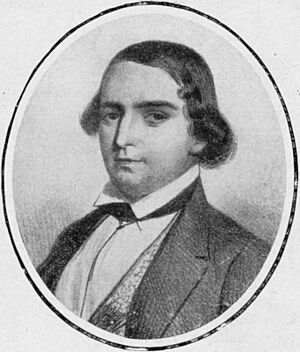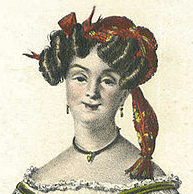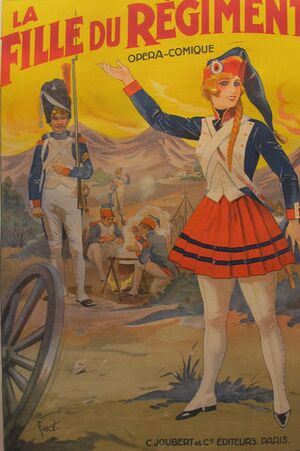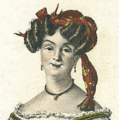La fille du régiment facts for kids
Quick facts for kids La fille du régiment |
|
|---|---|
| by Gaetano Donizetti | |
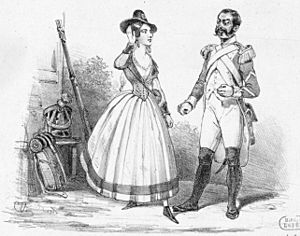
Euphrasie Borghèse as Marie and François-Louis Henry as Sulpice in the premiere
|
|
| Genre | Opéra comique |
| Librettist |
|
| Language | French |
| Premiere | 11 February 1840: Salle de la Bourse, Paris |
La fille du régiment (which means The Daughter of the Regiment) is a fun, two-act French opera. It was written by Gaetano Donizetti with a story (called a libretto) by Jules-Henri Vernoy de Saint-Georges and Jean-François Bayard. This opera was first performed on February 11, 1840, at a theater in Paris called the Salle de la Bourse.
Donizetti created this opera while he was living in Paris. He was also working on other operas at the time. La fille du régiment was his first opera written entirely in French.
This opera quickly became very popular. One reason is a famous song called "Ah! mes amis, quel jour de fête!" This song is very challenging for the tenor singer because it requires them to sing many high C notes. There is also an Italian version of the opera, called La figlia del reggimento, which was changed a bit for Italian audiences.
Contents
Performance History: How the Opera Became Famous
First Shows in Paris
The very first performance of La fille du régiment almost didn't go well. Some people said the main male singer was often off-key. A famous French critic, Hector Berlioz, didn't like it much at first. He thought Donizetti was writing too many operas for Paris.
However, another critic, Théophile Gautier, had a different view. He felt Donizetti's music was "beautiful and worthy." Despite the rocky start, the opera soon became a huge hit at the Opéra-Comique theater in Paris. It was performed 500 times by 1871 and reached its 1,000th show in 1908!
Performances Around the World
The opera traveled outside France. It was first shown in Italy in 1840, but people there didn't like it much at first. It only became popular in Italy in 1928.
In America, La fille du régiment was first performed in New Orleans in 1843. It then came to New York City. Critics in New York loved it, especially the singer Julie Calvé who played Marie. Many famous singers, like Jenny Lind and Adelina Patti, enjoyed performing the role of Marie.
The opera also came to England in 1847. It was first sung in Italian, then later in English.
The Opera in the 20th Century and Today
The Metropolitan Opera in New York first performed this opera in 1902. It has been brought back to the stage many times since then.
The song "Ah! mes amis, quel jour de fête!" is still famous today. It's known as a very difficult song for tenors because of its many high C notes. In 1972, Luciano Pavarotti became a huge star after his amazing performance of this song at the Met. He sang the high Cs perfectly, which amazed everyone.
Later, in 2007, Juan Diego Flórez sang this song at La Scala in Italy. The audience loved it so much that they asked for an encore (a repeat performance). He sang it again, which was very rare at La Scala! He repeated this amazing feat in New York in 2008. In 2019, another tenor, Javier Camarena, also sang an encore of the aria at the Met.
Sometimes, a non-singing role in the opera, the Duchess of Crakenthorp, is played by famous actors or retired opera stars. For example, Ruth Bader Ginsburg, a US Supreme Court Justice, once played this role.
Today, La fille du régiment is a regular part of opera performances around the world.
Characters in the Opera
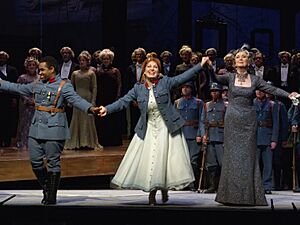
| Role | Voice type | First Performance, February 11, 1840 |
|---|---|---|
| Marie, a vivandière (canteen girl) | coloratura soprano | Euphrasie Borghèse |
| Tonio, a young man from Tyrol | tenor | Mécène Marié de l'Isle |
| Sergeant Sulpice | bass | François-Louis Henry ("Henri") |
| The Marquise of Berkenfield | contralto | Marie-Julie Halligner ("Boulanger") |
| Hortensius, a butler | bass | Edmond-Jules Delaunay-Ricquier |
| The Duchess of Crakentorp | spoken role | Marguerite Blanchard |
The Story of the Opera
- Time: The early 1800s, during the Napoleonic Wars
- Place: The Swiss Tyrol region
Act 1: Marie and the Regiment
The story begins in the Tyrol mountains during wartime. The Marquise of Berkenfield is traveling and is very scared. Suddenly, Sergeant Sulpice of the French army's Twenty-First Regiment arrives. He tells everyone the army will keep order.
Marie, the regiment's canteen girl, enters. Sulpice is happy to see her. He asks her about a young man she's been seen with, and she says his name is Tonio. Just then, Tonio is brought in as a prisoner because he was seen near the army camp. Marie saves him by explaining that he once saved her life. Everyone celebrates Tonio, and Marie sings the regiment's special song.
Marie explains to Tonio that the soldiers of the regiment are like her "fathers." They found her as a baby on the battlefield and adopted her. Tonio tells Marie he loves her, and they sing about their love.
Sulpice returns, and the Marquise arrives. She is trying to get back to her castle and asks for an escort. Sulpice hears the name Berkenfield and realizes it matches a letter found with baby Marie. It turns out Marie is the Marquise's long-lost niece!
The Marquise demands that Marie come with her to learn how to be a proper lady. Marie says goodbye to her beloved regiment. Tonio then announces he has joined the army so he can be with Marie. He asks for her hand in marriage, but the soldiers are shocked. Marie has to leave with her aunt, and Tonio is very upset.
Act 2: A Lady in Training
Marie has been living in the Marquise's castle for several months. The Marquise wants to change Marie's army habits and make her a refined lady. She wants Marie to marry her nephew, the Duke of Crakenthorp. Marie isn't happy about this, but she agrees. Sulpice is also at the castle and tries to help Marie adjust. When Marie is asked to play the piano, she still prefers military music!
Marie is left alone and feels sad about her fate. But then, she hears military music and becomes very happy! The regiment arrives, and Tonio is with them, now an officer. Marie, Tonio, and Sulpice are all very happy to be together again. Tonio says he has learned a secret about the Marquise.
The Marquise is horrified to see the soldiers. Tonio asks for Marie's hand in marriage, explaining he risked his life for her. But the Marquise refuses. Tonio then reveals that the Marquise never had a niece. After Tonio and Marie leave, the Marquise tells Sulpice the truth: Marie is actually her own daughter, born out of wedlock. Sulpice promises Marie will agree to her mother's wishes.
The Duchess of Crakenthorp and her son (the groom) arrive for the wedding. Marie enters, and Sulpice has told her that the Marquise is her mother. Marie hugs her mother and decides she must obey. But at the last moment, the soldiers of the Regiment burst in! They tell everyone that Marie was a canteen girl. The wedding guests are shocked, but then Marie sings about how much she owes the soldiers. The Marquise is deeply moved and finally admits she is Marie's mother. She gives her blessing for Marie and Tonio to marry, and everyone celebrates!
Films Based on the Opera
The opera has been made into several films:
- A silent film in 1929.
- A sound film in 1933, made in both German and French versions.
- Another film in 1953.
- A film in 1962 with John van Kesteren as Tonio.
Images for kids
-
Final curtain call of the Metropolitan Opera's performance of 24 December 2011 with (l to r) Lawrence Brownlee (Tonio), Nino Machaidze (Marie), and Ann Murray (Marquise)
See also
 In Spanish: La hija del regimiento para niños
In Spanish: La hija del regimiento para niños


